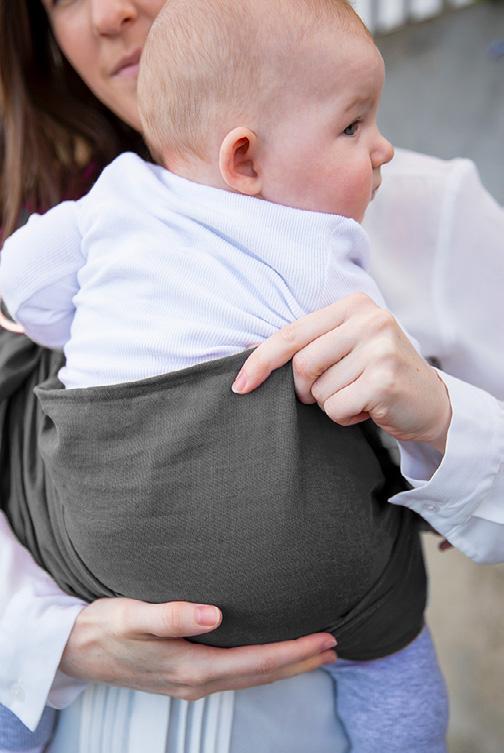
4 minute read
Babywearing: Ring Slings
Babywearing
RING SLINGS
Advertisement
Words Kellie Rakich Photo Sarah Walker
Ring slings are often touted as being one of the best options of carrier for newborns, and beginner babywearers. Once mastered, they are quick to slip on and off; easy to thread and tighten; and best of all, they are usually no larger than an A4 booklet when folded up, so are able to be popped into most regular size handbags.
THE HISTORY
The modern-day ring sling is the brainchild of Rayner Garner; a Hawaiian man who created a carrier that had two rings and padded edges, for his wife to use for wearing their baby. That was in 1981 - and today, nearly 40 years later, the modern babywearing movement has several different types of ring slings, in a variety of fibres and styles, for parents and caregivers to choose from.
THE BASICS
A ring sling is a piece of fabric around 2 metres in length, with two specially made rings at one end. It is designed to be worn as a one-shoulder carrier, with the child positioned on either the front or hip of the wearer. The fabric is fastened by threading the end through the rings and is secured by the tension created from the weight of the child bearing downwards, thus stopping the fabric from slipping out of the rings.
THE SHOULDER STYLES
There are several different shoulder styles of ring sling, which provide wearers with options for comfort, depending on personal preference. Here are descriptions of the two most popular styles.
Gathered: The gathered shoulder style is a simple ‘gathering’ of the fabric, which allows the wearer to widely distribute fabric. This is especially useful for carrying heavier children.
Pleated: The pleated shoulder style is extremely useful for beginner ring sling users, as it fans out over the shoulder, and doesn’t require much adjustment.
THE FABRIC
Ring slings, like other woven carriers, have a multitude of fabrics and blends available; all of which is personal preference. 100% cotton is a common option available, and is popular for several reasons; it’s a breathable fabric that is supportive, easy care, and able to be sustainably produced.
Cotton blends using fibres such as linen, tencel, hemp, and wool are also popular options. These blends create further choice that recognises differences in climates, as well a support for heavier children.
OTHER BENEFITS
Ring slings are extremely portable, as previously stated. They’re a convenient carrier that is easily transportable, as well as being relatively quick to use. This comes in handy for situations such as inclement weather, whereby you need a quick ‘up’; a fussy child who is impatient for their needs to be met and cannot tolerate a longer timeframe of getting into a carrier; at an airport or when travelling, where the tool of babywearing is invaluable for ease and convenience.
I highly recommend going along to a babywearing meet if you can, to try out some different styles and blends of ringslings, to see which suits you best; but in general terms, a ring sling is a wonderful addition to any babywearing parent or caregiver’s toolkit, and will serve you from newborn to toddlerhood and beyond.
When teaching caregivers how to use a ring sling, I always say that setting up the rings correctly, before you pop your baby in, is paramount to a comfortable carry. The most common mistake made is that the fabric is all bunched in the rings and when it comes to tightening, they pull down on the whole tail of fabric. This moves the rings, doesn’t make the fabric firm in the right areas and can make the carry feel uncomfortable and at times, unsafe.
To thread your ring sling, begin by placing the end with the rings over one shoulder.
Gather the fabric of the tail end in your hand and bring it through both rings.
Bring the fabric over the top ring, then through the bottom ring. Make sure the top rail and bottom rail are sitting neatly on the outside of the rings.
Pull the tail end of the fabric down to create the pouch for your baby.
Pick up your baby and hold him up at your shoulder. Bring one hand up underneath the pouch of the ring sling and use it to guide your baby down into the sling.
Position your baby on the gathered fabric to make the M shape with his legs (knees higher than hips).
Keep one hand on your baby to support him while you position his knees above his bottom and pull the fabric of the sling up to the base of his neck.
Pull the top rail to tighten the sling.
Tighten, ‘strand by strand’ by working along the width of the tail to pull any excess fabric through the rings until your baby feels supported entirely by the sling.
10. Lastly pull down on the bottom rail. Not too tight or your baby will lose the M position and ‘pop’ their seat.
Baby is high, supported and close enough to kiss. If you remember these three things, then you have a safe and comfortable carry.
Sources: ‘The History of Babywearing and ‘Modern’ Slings.’
ankalia.com.au



Step 8




